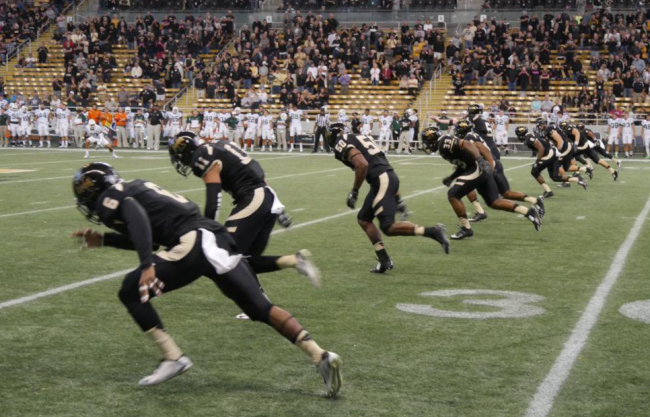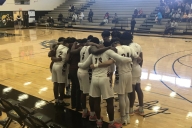You have /5 articles left.
Sign up for a free account or log in.

University of Idaho
After two decades of playing at college football's most competitive and high-profile level, the University of Idaho will make the unprecedented move to leave the Football Bowl Subdivision and return to the Football Championship Subdivision.
The university will announce the change today, accepting an invitation to join the Big Sky Conference after its membership with the Sun Belt Conference was not renewed last month. The decision comes at a time when faculty and student groups at other colleges with struggling FBS teams have urged their institutions to consider moving away from big-time college sports amid an accelerating athletic arms race. Until Idaho, however, no institution that managed to climb to the exalted ranks of the FBS had ever decided to drop back down.
“This is not a trivial decision, but it’s the right decision,” Chuck Staben, the University of Idaho’s president, said in an interview Wednesday. “What attracts students to our institution is the quality of academic programs, the great outcomes and the preparation for life after college. It’s a great research institution. Football and athletics just complements that. We’re choosing to ensure that students can compete on the field and get a great education.”
Idaho’s choice to leave the FBS was made easier, Staben said, by the Sun Belt’s decision not to renew the university’s membership earlier this year.
Idaho’s football team joined the Football Bowl Subdivision, the National Collegiate Athletic Association’s highest competitive level, in 1996 as a member of the Big West Conference, before briefly joining the Sun Belt Conference and then the Western Athletic Conference. After the Western league dropped football in 2012, Idaho’s football team spent one season as an independent program before returning to the Sun Belt Conference. Most of Idaho’s other teams continued to play with the Big Sky Conference, an FCS league that the university co-founded.
Today, Idaho has the lowest revenue in the FBS and its football team plays in the division’s smallest stadium, an enclosed concrete structure that seats 16,000. In its two decades at the FBS level, Idaho’s football team had just three winning seasons.
Earlier this year, the National Collegiate Athletic Association passed new rules allowing FBS conferences with fewer than 12 members to organize title games. No longer needing to split revenue among 12 institutions in order to hold a championship game, the Sun Belt Conference cut loose Idaho and New Mexico State University. Starting in 2018, the two programs would be without a league.
Facing a future of either returning to playing as an independent team, while awaiting a potential invitation from another FBS league, or accepting an invitation to rejoin the Big Sky Conference, the university chose the FCS option. “Frankly, had we been extended in the Sun Belt, this would be a much more difficult decision,” Staben said, adding that the university will lose $500,000 in revenue after its membership with the Sun Belt Conference ends.
That loss of revenue is not a major concern, Staben said, as the move also means offering about 22 fewer football scholarships per year and saving money on travel. The university is nearly 2,000 miles from its nearest opponent in the Sun Belt Conference.
As word of the change began to spread among Idaho football fans this week, critics of big-time college sports welcomed the news. Few institutions -- no matter how much money and how many games their teams lose -- make the decision to leave big-time college football.
“I think this is going to be a fantastic move for them, geographically and culturally,” David Ridpath, a professor of sports administration at Ohio University, said. “Sadly, I don’t think this is the start of a trend, at least not yet. Too many institutions hold on to the idea that Division I and the FBS is what makes them a relevant university. Perhaps if people see that Idaho dropping down is not the end of the world, the floodgates will open. This could be a good test case.”
In Rare Company
In 1939, the University of Chicago abolished its football program and, a few years later, withdrew from the Big Ten Conference, a league it co-founded.
Chicago was home to the first recipient of the Heisman Trophy, multiple Big Ten championships and 11 future Hall of Famers. But Robert Hutchins, the university’s president, wanted the university to be known for its academics, not its athletics, and cut the program. The football team returned in 1969, but as a member of Division III.
The decision forever made Chicago the model of institutions that have gotten by just fine without big-time sports. Staben, while explaining Idaho’s decision in an interview this week, referenced Chicago as “the classic example” of an institution successfully leaving top-tier college sports behind. Chicago remains the example, in part, because so few others have followed suit.
With the exception of University of the Pacific in 1995, Division I colleges that have dropped their football programs have mostly been institutions with programs that exist outside of the FBS, such as Northeastern University and Boston University.
In 2014, the University of Alabama at Birmingham became the first institution in nearly 20 years to shut down its big-time Division I football program. Citing rising costs and the growing stratification of college sports, Ray Watts, the university’s president, said killing the program would help save Birmingham $50 million over the next decade. The announcement, however, created an intense backlash on campus, setting off a tumultuous six months for Watts and the university, eventually resulting in a complete reversal of the decision.
Last year, some faculty and students at the University of Akron urged the university to decrease football spending by dropping to the FCS. The university’s president said at the time that such a move was not “on the table.” Earlier that year, a $60 million deficit had prompted the university to announce staff layoffs and the elimination of its baseball team. Meanwhile, the university was spending $8 million per year to subsidize a football team with the lowest attendance in the Football Bowl Subdivision.
The Faculty Senate and student government at Eastern Michigan University last week also told university administrators that its heavily subsidized FBS football team should leave for the FCS. “We have absolutely no plans to eliminate football or move into any other division or conference,” the university bluntly said in response.
During a Faculty Senate meeting at the University of Massachusetts at Amherst Thursday, some faculty urged the university to move its football team to a lower division. The team joined the FBS in 2011, but has struggled to find a permanent conference home. The faculty's motion was defeated, with the university's chancellor calling the debate "a waste of this important body's time."
The University of Idaho, too, relies on subsidies, including student fees, to fund its football team. Its level of spending and the revenue the team generates are on par with FCS programs, not the power players in the FBS. According to an analysis by the university of spending among FBS conferences, the program would need an additional $4 million per year to compete with even the midtier teams in the division. The move to the FCS is not intended to save the institution money, the university said, but it will transition the team to a level of competition where programs have “similar expenditure levels” to Idaho.
“The game we signed up for has changed over time," Rob Spear, the university's athletic director, said.
In the 11 seasons before Idaho’s football team joined the FBS, the program made a playoff game 10 times. As an FBS team, the team has appeared in just two bowl games, though the team won both games. The team has averaged only three wins per season since 1996.
“Our decision should be and is based primarily on the student and student-athlete experience,” Staben said. “I want our football players to walk on the field knowing they can compete for a championship. I want our students to attend a game that matters, excites them and engages them.”
Tearing Down the Front Porch?
Being unable to compete successfully in football, Staben said, has damaged the university’s brand. Some university alumni and team boosters said they are worried that leaving the FBS will hurt the brand even more.
University officials said this week that surveys of -- and conversations with -- students, faculty and alumni show that many support moving to the FCS. About half of the university’s alumni, Staben estimated, “including some very strong supporters of the university such as several past booster club presidents,” do not.
“We cannot compete for students -- let alone student-athletes -- if we continue to treat our athletic programs as an afterthought,” Jonathan Parker, president of the Ada County chapter of Idaho’s booster organization, the Vandal Scholarship Fund, wrote in a letter to the university last week. “Alumni who have showed up through thick and thin, with their pocketbooks and their shoe leather, want our football team to remain FBS.”
The chapter’s board also expressed concern that the move to the FCS -- with the loss of revenue and reduction of football scholarships -- would force the university to eliminate women’s sports programs in order to remain in compliance with federal gender equity laws. Staben said he does not anticipate shutting down any women’s programs, and that the loss of 22 football scholarships would actually bring the number of male and female athletic scholarships closer together due to a previous abundance of men’s scholarships.
Women's swimming and soccer were added in 1996 to support the move to the FBS, so some alumni remain skeptical.
In another letter, Robie Russell, the president of the Puget Sound chapter of the Vandal Scholarship Fund, wrote that if the team leaves the FBS, local interest in “Idaho athletics would virtually disappear with the move, along with any potential for financial support.” Contributions to the university would decline or “cease entirely,” Russell warned.
With its proximity to Washington State University and Boise State University, Russell wrote, moving to the FCS would be a “huge and potentially fatal mistake” for the university, leaving it unable to compete with nearby institutions.
“Last time I checked, the newspapers have sports pages, and they don’t have education pages,” Russell said in an interview Wednesday. “In the culture that we live in, college football is a very important aspect of life. The FCS gets little or no coverage. It’s not on national TV. An FBS team is the college’s front porch. It’s akin to advertising your business. Students want to go where things are happening. And at FCS schools, nothing is happening.”
As the football team will remain a member of the Sun Belt Conference until 2018, Russell said he also believes the university unnecessarily rushed the decision. Staben, however, said he’s been thinking about the move since he first interviewed to be Idaho’s president in 2014.
“I’ve been considering this issue for two years,” Staben said. “I’ve looked at information about FCS football and FBS football. I’ve listened to donors, students, faculty, alumni, fellow presidents, the NCAA, conference commissioners. I’ve gathered a lot of information. And all of the information points to this being the right decision.”








